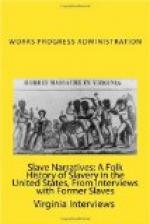Interviewer: Miss Irene Robertson
Person interviewed: Lucindy Allison, Marked Tree,
Arkansas
With
children at Biscoe, Arkansas
Age: 61
“Ma was a slave in Arkansas. She said she helped grade a hill and help pile up a road between Wicksburg and Wynne. They couldn’t put the road over the hill, so they put all the slaves about to grade it down. They don’t use the road but it’s still there to show for itself.
“She was a tall rawbony woman. Ma was a Hillis and pa’s name was Adam Hillis. He learned to trap in slavery and after freedom he followed that for a living. Ma was a sure ’nough field hand. Mama had three sets of children. I don’t know how many she did have in all. I had eleven my own self. Grandma was named Tempy and I heard them tell about when she was sold. She and mama went together. They used to whoop the slaves when they didn’t work up peart.
“When the ‘Old War’ come on and the Yankees come they took everything and the black men folks too. They come by right often. They would drive up at mealtime and come in and rake up every blessed thing was cooked. Have to go work scrape about and find something else to eat. What they keer ’bout you being white or black? Thing they was after was filling theirselves up. They done white folks worse than that. They burned their cribs and fences up and their houses too about if they got mad. Things didn’t suit them. If they wanted a colored man to go in camp with them and he didn’t go, they would shoot you down like a dog. Ma told about some folks she knowd got shot in the yard of his own quarters.
“Us black folks don’t want war. They are not war kind of folks. Slavery wasn’t right and that ‘Old War’ wasn’t right neither.
“When my children was all little I kept Aunt Mandy Buford till she died. She was a old slave woman. Me and my husband and the biggest children worked in the field. She would sit about and smoke. My boys made cob pipes and cut cane j’ints for ’er to draw through. Red cob pipes was the prettiest. Aunt Mandy said her master would be telling them what to do in the field and he say to her, ‘I talking to you too.’ She worked right among the men at the same kind of work. She was tall but not large. She carried children on her right hip when she was so young she dragged that foot when she walked. The reason she had to go with the men to the field like she did was ’cause she wasn’t no multiplying woman. She never had a chile in all her lifetime. She said her mother nearly got in bad one time when her sister was carrying a baby. She didn’t keep up. Said the riding boss got down, dug a hole with the hoe to lay her in it ’cause she was so big in front. Her mother told him if he put her daughter there in that hole she’d cop him up in pieces wid her hoe. He found he had two to conquer and he let her be. But he had to leave ’cause he couldn’t whoop the niggers.




